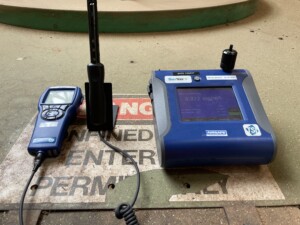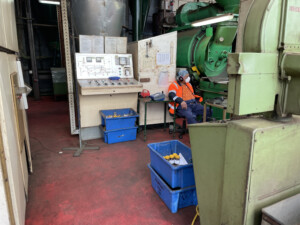Dust is a general term for fine particles suspended in the atmosphere. Dust can be generated by wind, disturbance of materials, release of gases, or some types of chemical reaction.
Dust can come from a wide variety of industrial activities, including:
- filling bags or emptying them into skips or other containers
- weighing loose powders
- cutting materials (for example, paving stones)
- sieving and screening operations
- conveying materials by mechanical means or by hand
- stockpiling large volumes of processed materials
- crushing and grading
- milling, grinding, sanding down or other similar operations
- cleaning and maintenance work
- handling livestock feed and bedding
- working with livestock and animal waste
- clearing up spillages.
While any type of dust can carry health risks, asbestos and silica dust are particularly harmful to health and are treated separately. Airsafe offers specialised services in asbestos air monitoring and respirable crystalline silica monitoring.

Inhalable dust vs respirable dust
Airsafe offers dust testing throughout Sydney and NSW for both inhalable dust and respirable dust. Respirable dust is a subset of inhalable dust, consisting of the smallest particles that penetrate the deepest into the respiratory system. Each type of dust has its own sampling method and exposure standards.
Inhalable dust consists of dust particles that are less than or equal to 100 micrometres in size – about one thirteenth the thickness of a five-cent piece. Inhalable dust particles can be inhaled through the nose or mouth. The human body gets rid of most inhalable dust by filtering it through nasal hair and mucous membranes, and by coughing and sneezing. However, too much inhalable dust can cause health and workplace safety issues including:
- reduced visibility
- symptoms such as runny nose, sneezing, watering eyes, coughing
- conditions such as rhinitis and bronchitis.
Respirable dust consists of dust particles that are less than or equal to 10 micrometres in size – about 1/130 the thickness of a five-cent piece. These particles are generally invisible except in certain lighting conditions. This is the subset of inhalable dust particles that are small enough to enter deep into the lungs where oxygen and carbon dioxide exchange occurs.
Most respirable dust is removed by white blood cells in the lungs. However, if too much respirable dust enters the lungs, it can overwhelm the body’s defence system. These particles can accumulate in the lung tissues, causing scarring and inflammation over time. This can lead to conditions including:
- emphysema
- chronic bronchitis
- chronic obstructive pulmonary disease (COPD).
Respirable particles are normally too fine to see, except in specific lighting conditions.
Airsafe conducts respirable dust monitoring and testing services in accordance with AS 2985-2009 Workplace atmospheres – Method for sampling and gravimetric determination of respirable dust. We compare the results to the Workplace Exposure Standards for Airborne Contaminants. There are exposure standards for specific substances, as well as guidance about exposure levels for dust not otherwise specified.
The variety of different exposure standards, and the different sampling methods for inhalable and respirable dust, make dust a complex regulatory area. Expert help is essential in ensuring you meet your duty of care to workers with as little as possible disruption to your business activities.
-
Work health and safety regulations require employers, in consultation with workers, to identify hazards, assess risks and implement practical controls to protect workers’ health and safety.
If monitoring shows that inhalable or respirable dust poses a risk to your workers, Airsafe can help you manage that risk.
We can also help you develop a dust exposure assessment strategy and implement regulatory requirements. With our decades of experience in managing all kinds of workplace risks, you can be confident that you’re in the right hands with Airsafe.
-
When advising you on how to control dust exposure, Airsafe will base our advice on the hierarchy of control, assessing the following options in order of priority:
- Elimination: eliminating activities that generate dust, for instance using wet instead of dry methods
- Substitution: using materials that are less likely to generate dust, if available
- Engineering controls such as physical barriers, ventilation systems or dust collection devices
- Administrative controls such as training or shift rotation
- Personal protective equipment such as masks or respirators.
We will advise you on a course of action that ensures you meet your legal obligations with the least possible financial and operational impact on your business.
-
While asbestos and silica dust receive most of the publicity around dust hazards, wood is another common source of workplace dust. Dust can be generated either by machining operations like sawing, routing and turning, or by hand or machine sanding. Controls must be put in place to ensure workers aren’t put at risk.
Health hazards from exposure to wood dust are similar to those from other types of dust, but there are particular concerns about cancers of the paranasal sinuses and nasal cavity in people with long-term exposure to wood dust.
SafeWork NSW has released a guidance note on minimising health risks from exposure to wood dust. They note that there are several ways of managing the risk, including installation of a local exhaust ventilation (LEV) system. They also note the importance of monitoring dust levels.
If your workplace involves activities that generate good dust, ensure you’re complying with your duty of care towards your workers: contact Airsafe for an assessment and advice.
Contact us for dust monitoring and testing services today
Airsafe delivers safe, comprehensive dust monitoring and testing services across Sydney and Australia. To organise a dust monitoring assessment, get in touch with us today on 1300 888 338.





